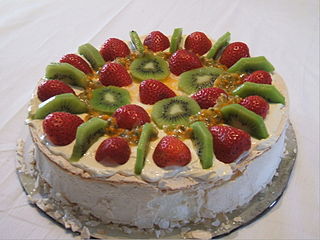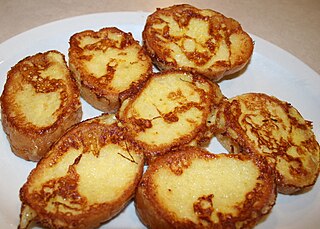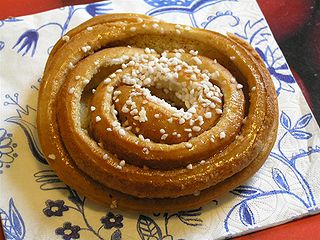
Pavlova is a meringue-based dessert. Originating in either Australia or New Zealand in the early 20th century, it was named after the Russian ballerina Anna Pavlova. Taking the form of a cake-like circular block of baked meringue, pavlova has a crisp crust and soft, light inside. The confection is usually topped with fruit and whipped cream. The name is commonly pronounced pav-LOH-və or pahv-LOH-və, and occasionally closer to the name of the dancer, as PAHV-lə-və.

A doughnut or donut is a type of food made from leavened fried dough. It is popular in many countries and is prepared in various forms as a sweet snack that can be homemade or purchased in bakeries, supermarkets, food stalls, and franchised specialty vendors. Doughnut is the traditional spelling, while donut is the simplified version; the terms are used interchangeably.

Hungarian or Magyar cuisine is the cuisine characteristic of the nation of Hungary and its primary ethnic group, the Magyars. Traditional Hungarian dishes are primarily based on meats, seasonal vegetables, fruits, bread, and dairy products.

French toast is a dish of sliced bread soaked in beaten eggs and often milk or cream, then pan fried. Alternative names and variants include "eggy bread", "Bombay toast", "gypsy toast", and "poor knights".

Pirozhki are foremost, Russian baked or fried yeast-leavened boat-shaped buns with a variety of fillings. Pirozhki are a popular street food and comfort food in Eastern Europe.

A semla, vastlakukkel, laskiaispulla, Swedish eclair, fastlagsbulle/fastelavnsbolle or vēja kūkas is a traditional sweet roll made in various forms in Sweden, Finland, Norway, Denmark, the Faroe Islands, Iceland, Estonia, and Latvia, associated with Lent and especially Shrove Tuesday in most countries, Shrove Monday in Denmark, parts of southern Sweden, Iceland and Faroe Islands or Sunday of Fastelavn in Norway. In Sweden it is most commonly known as just semla, but is also known as fettisdagsbulle. In the southern parts of Sweden, as well as in Swedish-speaking Finland, it is known as fastlagsbulle. In Estonia it is called vastlakukkel. In Norway and Denmark it is called fastelavnsbolle. In Iceland, it is known as a bolla and served on Bolludagur. In Faroe Islands it is called Føstulávintsbolli, and is served on Føstulávintsmánadagur. In Latvia, it is called vēja kūkas. Semla served in a bowl of hot milk is hetvägg.

A cinnamon roll is a sweet roll commonly served in Northern Europe and North America. In Sweden it is called kanelbulle, in Denmark it is known as kanelsnegl, in Norway it is known as kanelbolle, skillingsbolle or kanelsnurr, in Finland it is known as korvapuusti, in Iceland it is known as kanilsnúður, and in Estonia it is known as kaneelirull. In Austria and Germany, it is called Zimtschnecke.

Kuchen, the German word for cake, is used in other languages as the name for several different types of savory or sweet desserts, pastries, and gateaux. Most Kuchen have eggs, flour and sugar as common ingredients while also, but not always, including some fat. In Germany it is a common tradition to invite friends over to one's house or to a cafe between noon and evening to drink coffee and eat Kuchen.

A Berliner is a German jelly doughnut with no central hole, made from sweet yeast dough fried in lard or cooking oil, with a jam filling, and usually covered in powdered or conventional sugar.

Czech cuisine has both influenced and been influenced by the cuisines of surrounding countries and nations. Many of the cakes and pastries that are popular in Central Europe originated within the Czech lands. Contemporary Czech cuisine is more meat-based than in previous periods; the current abundance of farmable meat has enriched its presence in regional cuisine. Traditionally, meat has been reserved for once-weekly consumption, typically on weekends.

Mennonite cuisine is food that is unique to and/or commonly associated with Mennonites, a Christian denomination that came out of sixteenth century Protestant Reformation in Switzerland and The Netherlands. Because of persecution, they lived in community and fled to Prussia, Russia, North America, and Latin America. Groups like the Russian Mennonites developed a sense of ethnicity, which included cuisine adapted from the countries where they lived; thus, the term "Mennonite cuisine" does not apply to all, or even most Mennonites today, especially those outside of the traditional ethnic Mennonite groups. Nor is the food necessarily unique to Mennonites, most of the dishes being variations on recipes common to the countries where they reside or resided in the past.

Cuisine of Berlin describes different aspects of Berlin's culinary offerings. On the one hand, it means the traditional Berlin cuisine of Berlin households with dishes from the German cuisine. On the other hand, often a rustic pub and snack kitchen, which has become increasingly international due to many migration waves since 1945 and 1990. After 2000, numerous top-class restaurants have evolved in Berlin.












